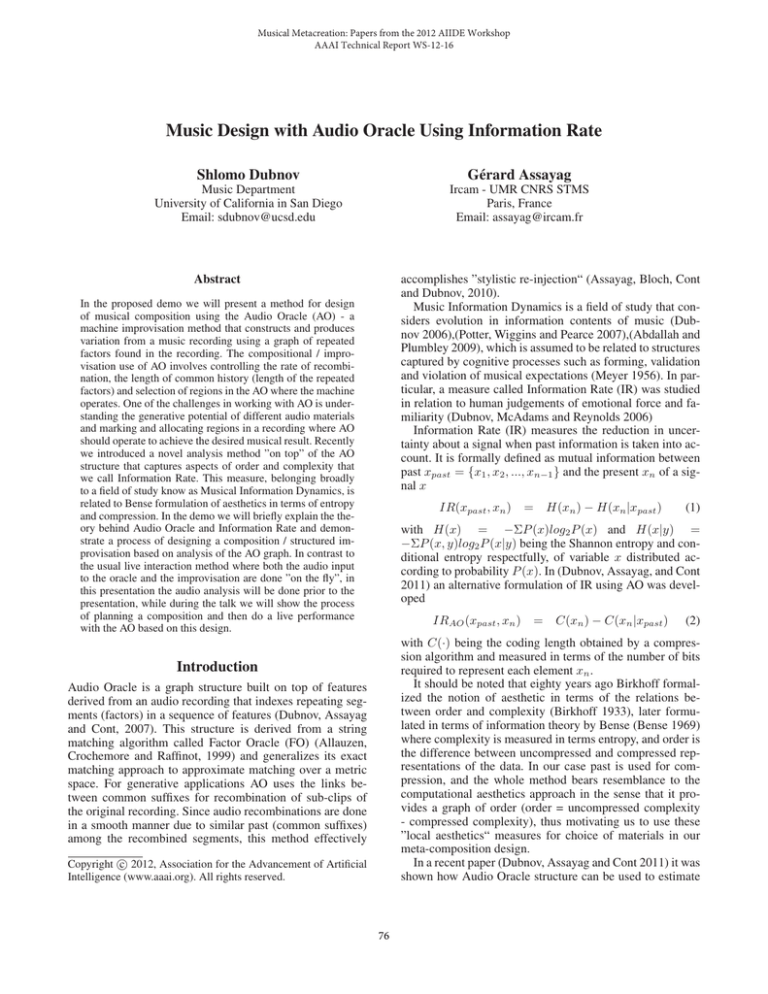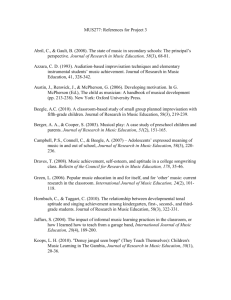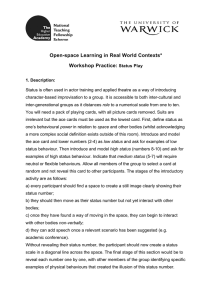Music Design with Audio Oracle Using Information Rate Shlomo Dubnov G´erard Assayag
advertisement

Musical Metacreation: Papers from the 2012 AIIDE Workshop
AAAI Technical Report WS-12-16
Music Design with Audio Oracle Using Information Rate
Shlomo Dubnov
Gérard Assayag
Music Department
University of California in San Diego
Email: sdubnov@ucsd.edu
Ircam - UMR CNRS STMS
Paris, France
Email: assayag@ircam.fr
Abstract
accomplishes ”stylistic re-injection“ (Assayag, Bloch, Cont
and Dubnov, 2010).
Music Information Dynamics is a field of study that considers evolution in information contents of music (Dubnov 2006),(Potter, Wiggins and Pearce 2007),(Abdallah and
Plumbley 2009), which is assumed to be related to structures
captured by cognitive processes such as forming, validation
and violation of musical expectations (Meyer 1956). In particular, a measure called Information Rate (IR) was studied
in relation to human judgements of emotional force and familiarity (Dubnov, McAdams and Reynolds 2006)
Information Rate (IR) measures the reduction in uncertainty about a signal when past information is taken into account. It is formally defined as mutual information between
past xpast = {x1 , x2 , ..., xn−1 } and the present xn of a signal x
In the proposed demo we will present a method for design
of musical composition using the Audio Oracle (AO) - a
machine improvisation method that constructs and produces
variation from a music recording using a graph of repeated
factors found in the recording. The compositional / improvisation use of AO involves controlling the rate of recombination, the length of common history (length of the repeated
factors) and selection of regions in the AO where the machine
operates. One of the challenges in working with AO is understanding the generative potential of different audio materials
and marking and allocating regions in a recording where AO
should operate to achieve the desired musical result. Recently
we introduced a novel analysis method ”on top” of the AO
structure that captures aspects of order and complexity that
we call Information Rate. This measure, belonging broadly
to a field of study know as Musical Information Dynamics, is
related to Bense formulation of aesthetics in terms of entropy
and compression. In the demo we will briefly explain the theory behind Audio Oracle and Information Rate and demonstrate a process of designing a composition / structured improvisation based on analysis of the AO graph. In contrast to
the usual live interaction method where both the audio input
to the oracle and the improvisation are done ”on the fly”, in
this presentation the audio analysis will be done prior to the
presentation, while during the talk we will show the process
of planning a composition and then do a live performance
with the AO based on this design.
IR(xpast , xn )
= H(xn ) − H(xn |xpast )
(1)
with H(x) = −ΣP (x)log2 P (x) and H(x|y) =
−ΣP (x, y)log2 P (x|y) being the Shannon entropy and conditional entropy respectfully, of variable x distributed according to probability P (x). In (Dubnov, Assayag, and Cont
2011) an alternative formulation of IR using AO was developed
IRAO (xpast , xn )
= C(xn ) − C(xn |xpast )
(2)
with C(·) being the coding length obtained by a compression algorithm and measured in terms of the number of bits
required to represent each element xn .
It should be noted that eighty years ago Birkhoff formalized the notion of aesthetic in terms of the relations between order and complexity (Birkhoff 1933), later formulated in terms of information theory by Bense (Bense 1969)
where complexity is measured in terms entropy, and order is
the difference between uncompressed and compressed representations of the data. In our case past is used for compression, and the whole method bears resemblance to the
computational aesthetics approach in the sense that it provides a graph of order (order = uncompressed complexity
- compressed complexity), thus motivating us to use these
”local aesthetics“ measures for choice of materials in our
meta-composition design.
In a recent paper (Dubnov, Assayag and Cont 2011) it was
shown how Audio Oracle structure can be used to estimate
Introduction
Audio Oracle is a graph structure built on top of features
derived from an audio recording that indexes repeating segments (factors) in a sequence of features (Dubnov, Assayag
and Cont, 2007). This structure is derived from a string
matching algorithm called Factor Oracle (FO) (Allauzen,
Crochemore and Raffinot, 1999) and generalizes its exact
matching approach to approximate matching over a metric
space. For generative applications AO uses the links between common suffixes for recombination of sub-clips of
the original recording. Since audio recombinations are done
in a smooth manner due to similar past (common suffixes)
among the recombined segments, this method effectively
c 2012, Association for the Advancement of Artificial
Copyright Intelligence (www.aaai.org). All rights reserved.
76
IR of an audio recording. For the sake of completeness, we
will briefly recapitulate this method here. For more details
on the compression method itself the reader is referred to
(Lefebvre and Lecroq 2001).
new composition that is designed off-line. For on-line, realtime interaction approach, two main systems have been built
: Omax by Assayag, Bloch and Chemillier, an OpenMusic/Max application for co-improvisation with human performers using the Midi, audio and video media ; and MiMi
by A. Franois and E. Chew, a multimodal interface for coimprovisation with the computer that gives a visual feedback
to the performer, helping him to anticipate the computers reactions. Omax operation is usually done as a trio - human
musician-improviser, machine improviser and human operator of the machine. The role of the humans in this setting is
quite demanding - the musician creates initial musical materials and then listens and responds to machine improvisation. The human operator listens to the human musician and
controls the machine using his own taste and musical skills.
In this demo we separate between the steps of providing
musical input to the machine and control of machine improvisation. The recording, analysis and design of the piece will
be done off-line. The remaining live element in the demo
will be running the oracle according to compositional plan.
The process of creating the composition consists of the following steps:
• Using pre-recorded music materials to perform the AO
analysis.
• Preforming IR analysis of the AO graph structure.
• Manual design of composition based on AO visualization
and IR annotations.
• Live rendering of new improvisation according on the
compositional design.
To demonstrate the method we use IR analysis of an AO
created from a recording of Beethoven Piano Sonata No. 1
in F minor. Comparison to musicological analysis shows that
IR successfully captures salient structural aspects of musical
form. An additional graph (not shown here) points to the locations in the recording where the repetitions actually occur.
A possible improvisation scheme based on this information
is as follows:
• Select several short segments from the exposition section
as the main operating regions.
• Create an exposition by switching between several generative materials.
• Create a development section by improvising on the exposition starting with low recombination rate and gradually increasing the recombination rate and short repetition
length.
• For Cadence uses exposition materials with high minimal
repetition length.
It should be noted that during the performance the improvisation can be recorded back into an oracle. This allows reuse
of new and surprising materials in a later development. In the
demo similar types of analysis will be conducted on various
musical materials, with various features and time scales. In
terms of the ”aesthetic“ interpretation, the higher the graph,
the more order exists in that segment since it can be ”explained“ and hopefully perceived by pointing to an earlier
repetition.
Details of AO-IR calculation method
When a new frame (i+1) arrives to AO, a new suffix link and
the Longest Repeated Suffix (LRS) for this frame are computed. In case when no previous repetition was found the
suffix link points to state 0. In such case this new frame has
to be individually encoded. Otherwise if a suffix link to earlier position is found and the LRS is smaller then the number
of steps passed since the last encoding event, then the whole
preceding segment is encoded as a pair (length, position).
For example, in the symbolic case the word aabbabbabbab will be encoded as follows: The first letter will be encoded using the letter a using 1 bit over an alphabet {a, b}.
The next occurrence of a can be encoded as a pair (1, 1),
but since encoding it will take more bits then encoding a
individually, we will use the shorter encoding and proceed
to encoding next b individually and then deciding between
representing the following b as a pair (1,3) or as a single
letter, choosing the later option. The compression advantage
appears for the remaining portion of the string. According to
the encoding method this segment can be encoded as a pair
(8, 2), which will take log2 (8) + log2 (12) = 6.58 bits, practically offering 1 bit saving compared to encoding of the 8
characters individually.
In the AO case, the symbols are replaced by feature vectors, and in order to define the uncompressed complexity
C(xn ) we need to find a quantity that would be equivalent
to the log of the size of the alphabet in the symbolic case.
We do that by considering the number of forward links originating from state 0, δ(0, :), which requires log2 |δ(0, :)| bits.
Accordingly we define C(xn ) = log2 |δ(0, :)|, ∀n. From
the AO structure we find the points where the compression
occurs according to the method mentioned above. For every frame that occurs between the encoding events we compute the compression gain in terms of the number of bits required to represent the pair (length, position), divided by
the length of the encoded segment.
Algorithm 1 Information Rate using AO
Require: Array K containing a list of AO encoding event
occurrences, unconditional complexity C = log2 (|δ(0, :
)|, M = max(LRS), and sequence length N
1: for i = 1 to |K| − 1 do
2:
L = K(i + 1) − K(i)
2 (M )
3:
IR[K(i) : K(i+1)] = max(C− log2 (N )+log
, 0)
L
4: end for
5: return Array IR
Compositional Design for Machine
Performance
The main goal of the current presentation is to show how
AO can be used as a generator (high level instrument) in a
77
and spectral features, providing two oracles that give different structures for improvisation. Accordingly, IR can be
used not only for selection of materials within an oracle, but
also for switching between ”most informative“ or ”most aesthetic“ oracles at different points in time.
IR analysis derived from AO
10
EXPOSITION
EXP. REPEATED
DEVELOPMENT RECAPITULATION
9
8
IR (bits/frame)
7
Conclusion
6
Generating novel music from a recording can be done using AO. The low level repetition structure found by AO can
be used effectively for machine improvisation by creating
stylistic re-injections into music performed by a human improvisor. The re-injections, although stylistically coherent,
do not take into account larger musical structures. Using a
”compression oracle” we are able to analyze the AO structure in terms of information dynamic properties. We use Information Rate as a meta-feature for improvisation planning
in terms of higher level aesthetic categories. In the demo
we will present a larger scale planning process for a human
operator of a machine improvisation system. Aspects of notating the actions of a human operator and aesthetic criteria
for designing such composition will be discussed.
5
4
3
2
1
0
0
20
40
60
80
100
120
140
160
180
200
time (sec.)
Figure 1: AO IR analysis for Beethoven Sonata No. 1
To get an insight into the segmentation potential of the
AO-IR graph we compare it to the first eigenvector of a rowwise normalized pairwise distance matrix (so called Self
Similarity matrixthat can be interpreted as a transition probability matrix Pi,j between frames i and j. The eigenvector
v = Pv gives the stationary distribution under this Markov
model, and as we can see, the recurrent segments under AOIR correspond to frames with higher probability of occurrence under the more simple Markov model.
−3
x 10
References
Dubnov, S., Assayag, G. and Cont, A. 2007. Audio Oracle:
A New Algorithm for Fast Learning of Audio Structures, In
Proceedings of International Computer Music Conference
(ICMC).
Allauzen, C., Crochemore, M., and Raffinot, M. 1999. Factor oracle: A new structure for pattern matching, In Conference on Current Trends in Theory and Practice of Informatics: 295 - 310.
Assayag, G., Bloch, G., Cont, A. and Dubnov, S. 2010. Interaction with Style, In The Structure of Style: Algorithmic
Approaches to Understanding Manner and Meaning, S. Argamon, K. Burns, S. Dubnov, (Eds.), Springer
Dubnov, S., Assayag, G., and Cont, A. 2011. Audio Oracle
analysis of Musical Information Rate, In The Fifth IEEE International Conference on Semantic Computing, Palo Alto.
Dubnov. S., 2006. Spectral anticipations, Computer Music
Journal, 30(2):63 - 83.
Potter, K., Wiggins, G.A., and Pearce, M.T. 2007. Towards
greater objectivity in music theory: Information-dynamic
analysis of minimalist music, Musicae Scientiae 11(2): 295
- 322,
Abdallah, S. A. and Plumbley, M. D. 2009. Information dynamics: patterns of expectation and surprise in the perception of music, Connection Science, 21(2): 89 - 117.
Meyer, L. B. 1956. Emotion and Meaning in Music,
Chicago: Chicago University Press.
Dubnov, S., McAdams, S. and Reynolds, R. 2006. Structural
and Affective Aspects of Music From Statistical Audio Signal Analysis, Journal of the American Society for Information Science and Technology, 57(11): 1526 - 1536.
Lefebvre, A., and Lecroq, T. 2001. Compror: Compression
with a Factor Oracle, In Proceedings of the Data Compression Conference.
Recurrence plot from Markov eigenvector
Markov−eig
AO−IR
2
1.8
1.6
1.4
1.2
1
0.8
0.6
0.4
0.2
0
0
20
40
60
80
100
120
140
160
180
200
Figure 2: Recurrence profile using the first eigenvector of a
Markov Model derived from Cepstral Self Similarity. This
graph is compared to the AO based IR measure (dashed)
In (Dubnov, Assayag and Cont 2011) we showed how the
sum of IR values over the whole signal can be used to find
the optimal threshold for the AO estimate. Generalizing this
idea, we consider IRs of different features from AO’s constructed from different musical parameters. In our practice,
the most common features used for improvisation are pitch
78
Birkhoff, G.D. 1933, Aesthetic Measure, Harvard Univ.
Press.
Bense, M. 1969. Introduction to the Information-theoretical
Aesthetics, Foundation and Application to the Text Theory,
Rowohlt Taschenbuch Verlag, (In German).
79




